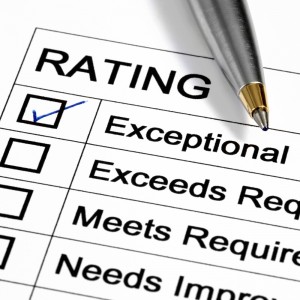Rater errors are errors in judgment that occur in a systematic manner when an individual observes and evaluates another.
What are the types of rater errors and why do they occur?
- The opposite of this is the horn effect, which occurs when the employee is seen as weak in one or more areas and is rated low in other areas based on that weakness. An example would be where an employee’s poor customer service skills negatively influences the evaluation of other relevant skills or causes the rater to overlook the employee’s superior skills when preparing the appraisal.
- One type of rater error is the halo effect. This error occurs when an employee is seen by the supervisor as highly competent in one or more areas and, as a result, is rated highly in other areas. For example, if an employee is a good record keeper but is occasionally late, the supervisor might overlook the tardiness because the positive work habit overshadows the problem behavior.
 Another rater error is the recency effect, which occurs when a supervisor considers only the most recent performance rather than the performance over a year (or the length of time the appraisal covers). This can be a serious issue if the employee has performed well all year, only to have a performance problem right before the evaluation takes place. Of course, the opposite can also be true, where an employee’s performance improves a few months before the appraisal and the manager only recalls the recent performance progress at the time of assessment.
Another rater error is the recency effect, which occurs when a supervisor considers only the most recent performance rather than the performance over a year (or the length of time the appraisal covers). This can be a serious issue if the employee has performed well all year, only to have a performance problem right before the evaluation takes place. Of course, the opposite can also be true, where an employee’s performance improves a few months before the appraisal and the manager only recalls the recent performance progress at the time of assessment.
- Contrast takes place when the appraiser rates one employee based on the work of other employees, rather than based on the performance standards for a particular position. One employee may be a “shining star,” which would make all other employees seem average in comparison, or an employee could be a constant performance problem, which then makes all of the other employees seem like superior performers in comparison.
- Bias occurs when a supervisor has prejudices against certain employees based on gender, age, religion, ethnicity, race, weight, disability, or some other non-job-related aspect. An additional rater error is strictness, which occurs when an appraiser believes that no employee can ever be worthy of the highest rating since “no one is perfect.” The opposite effect is called the leniency error. This happens when the supervisor believes that all employees put forward their best efforts, so they should all be worthy of a higher rating. A related error is called central tendency, which occurs when the rater believes that all employees are average and should fall somewhere in the middle of the rating scale.
- Sampling error occurs when the supervisor has observed only a small portion of the employee’s work and bases the rating only on what was witnessed. This situation might occur when an employee telecom-mutes or works in another location. It might also occur if the supervisor is new to the position and has worked with the employee only a short time. Ideally, a performance appraisal should take into consideration all of an employee’s work during the period of evaluation, even if more than one supervisor’s ratings needs to be considered.
- The final type of rater error is known as similar to or different from me. This type of error occurs when supervisors give higher ratings to employees who are similar to them in personality, interests, or other non-job-related issues. Of course, the opposite can also be true where supervisors give lower ratings to those employees who are not like them.
Rater errors are most common when one person is evaluating the performance of another. It is for this reason that ongoing training in performance appraisal is important. Companies and individual raters can find themselves in legal trouble if an employee is terminated for a poor performance appraisal based on rater errors. In addition, performance should be based on only job-related items and not on personal feelings. Each employee should be provided with his or her job description and job expectations prior to their performance review. There should be no surprises for the employees during the review about performance expectations. This is why consistent, ongoing feedback on performance is important. It should not be something that is discussed only once or twice per year—it should be a regular occurrence. Furthermore, corrective performance counseling should be provided on an ongoing basis so that the employee can improve performance all year. And finally, every appraisal process should include a method to appeal or disagree with the outcome.
See also:
- Performance appraisal and feedback
- Stereotyping of workers
- Three-hundred-sixty-degree (360°) evaluation
References:
- Armstrong, S. and Appelbaum, M. 2003. Stress-free Performance Appraisals: Turn Your Most Painful Management Duty into a Powerful Motivational Tool. Franklin Lakes, NJ: Career Press.
- Grote, R. C. 2002. The Performance Appraisal Question and Answer Book: A Survival Guide for Managers. New York: American Management Association.
- Mathis, R. and Jackson, J. 2003. Human Resource Management. Mason, OH: South-Western.
- Swan, W. S. 1991. How to Do a Superior Performance Appraisal. Indianapolis, IN: Wiley.